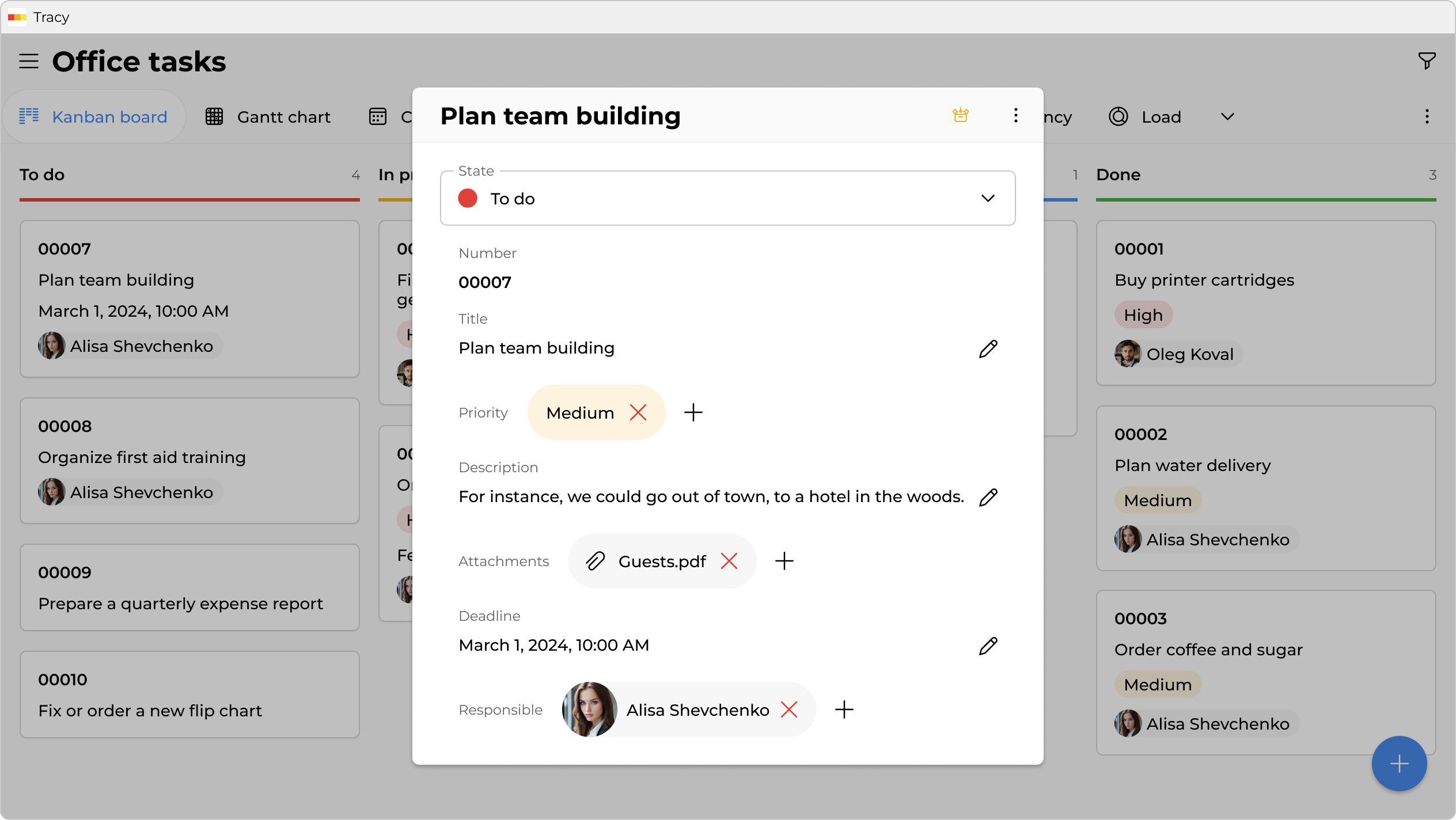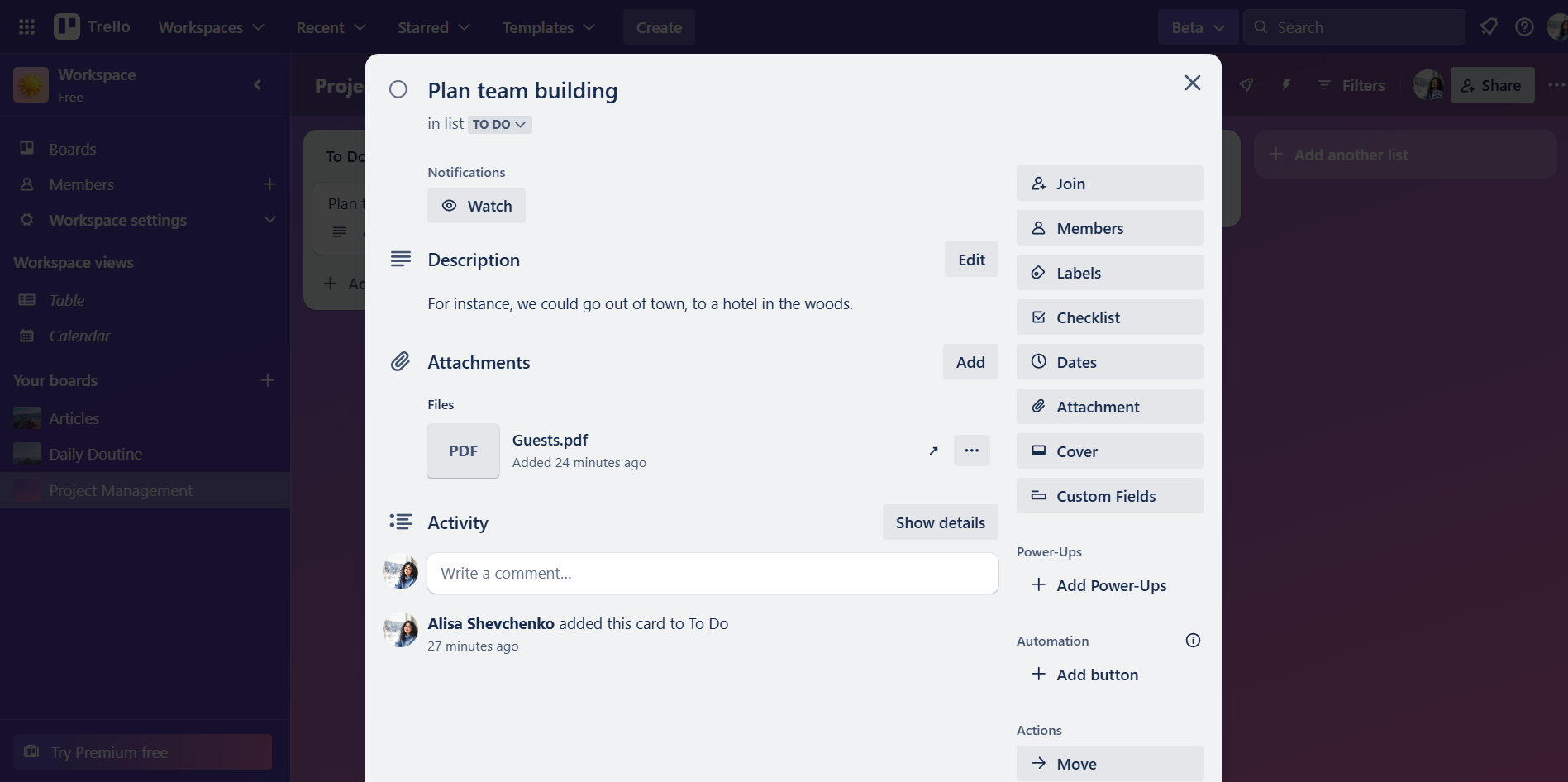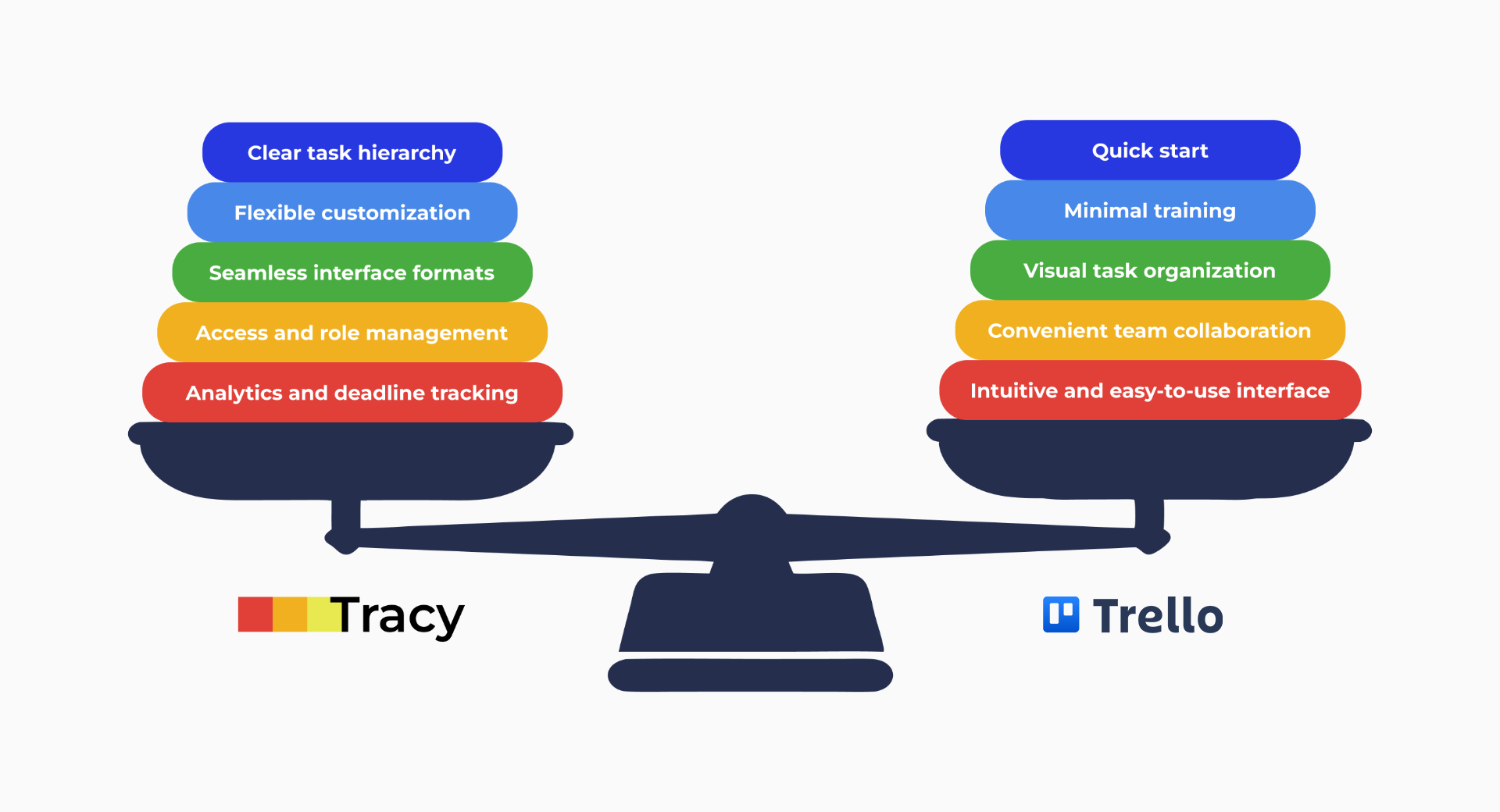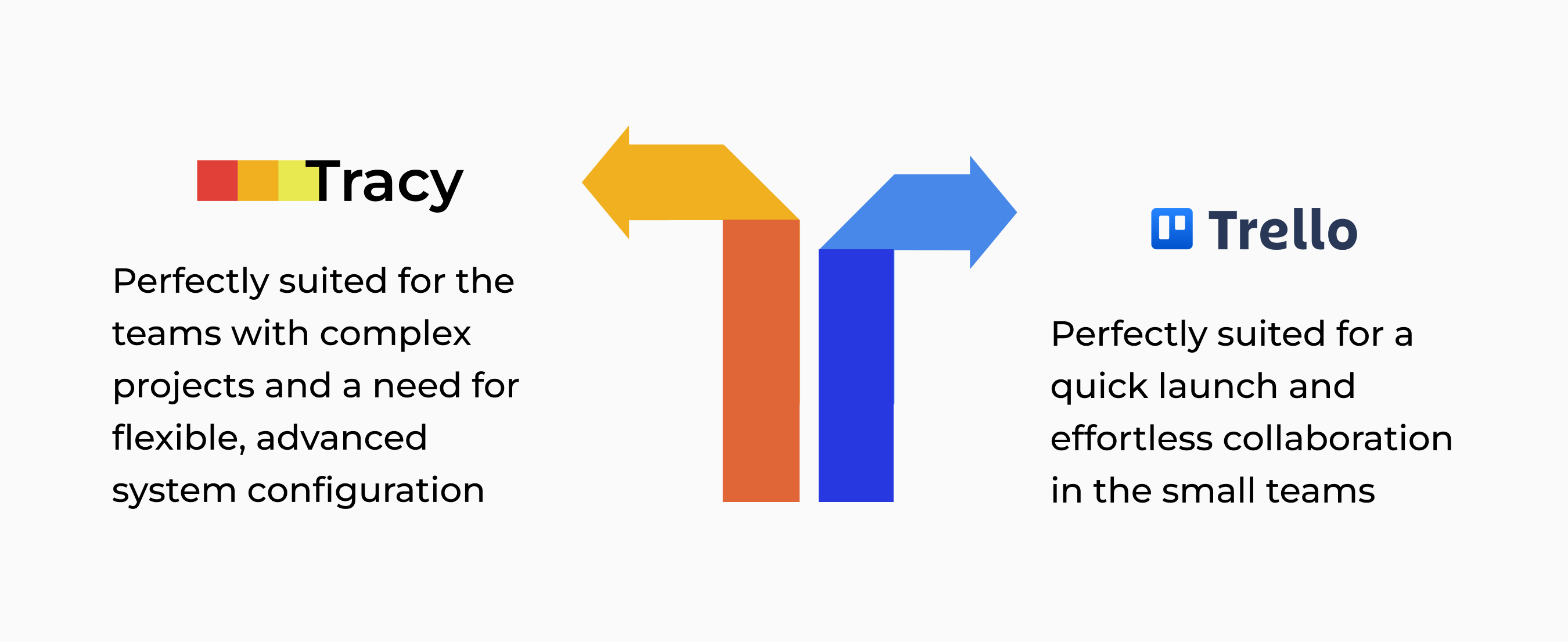Tracy vs Trello: What Is Better for Small Business?
In the modern business environment, effective project management is not a luxury but a necessity. This applies equally to large corporations and small businesses. If you choose the right tools, you can streamline workflows, boost productivity, and ensure clear communication within your team. Let’s take a look at two platforms with similar functionalities that can serve as such tools: Tracy and Trello.

General Overview of the Services
Tracy and Trello offer different approaches to project management, each with its own unique advantages and features. When choosing between them, it is important to consider the specifics of your business, team size, project types, and work processes. Keep in mind: there is no one-size-fits-all solution—your choice should be based on your company’s specific needs. So let’s start by reviewing both platforms.
Tracy
Tracy is a comprehensive project management system focused on optimizing workflows and improving team productivity. Simply put, it is like a smart organizer for your work. What can it do?

Tracy Features
- Task and project management: An intuitive task system that lets you set priorities, deadlines, and assign responsibilities.
- Time tracking: You can track the time spent on each task to optimize your processes. This is a key feature because it helps you evaluate the ROI of every operation.
- Process automation: Allows you to set up automatic actions based on specific conditions. Essentially, the platform takes over routine tasks, freeing up your time for more strategic business efforts.
- Analytics and reporting: Offers advanced tools to analyze team performance and project progress. In other words, the system shows how you are working, where most of your time goes, how quickly you are shipping products, and more.
- Resource management: Tools for efficiently distributing workloads among team members.
In summary, Tracy efficiently manages issues related to project planning, workflow optimization, and team coordination. Its productivity analysis and process bottleneck detection features are particularly valuable.
Trello
Trello is a visually-driven project management system based on the Kanban methodology. That might sound straightforward, and indeed, when you open the platform, it appears quite simple.
There is no doubt that Trello’s visual appeal is a major draw for users. However, this app is only simple at first glance. Once you start working with it—organizing data and managing real workflows—you will notice a significant downside behind its rich visual layout: a lack of advanced features.
So, what functions can we actually use in Trello?
Trello Features
- Boards, lists, and cards: Visual task organization based on the Kanban method for a clear presentation of workflow.
- Team collaboration: Simple tools for working together on projects.
- Integration with other services: Options to extend functionality through Power-Ups.
- Board templates: Ready-to-use templates for different types of projects and business processes.
- Automation settings: The Butler system for automating routine actions on boards.

So, Trello effectively addresses challenges related to workflow organization, project stage visualization, and task transparency. The platform is especially well-suited for teams that value simplicity and visual clarity. However, since the Kanban board is the core methodology in Trello, the platform’s functionality ultimately proves to be limited.
It is important to note that in Trello—unlike in Tracy—tools like time tracking can only be added through external integrations, meaning these features are not built into the app’s interface. In contrast, Tracy includes time tracking, Gantt charts, and other features as standard, so they are available even in the free plan.
Comparison of Key Features
Let’s take a closer look at the functionality available in both apps. We will start with the core task these tools are meant to solve—task and project management.
Task Management
Effective task management is the key to productivity. Tracy and Trello are both popular tools, but which one suits your needs better? Let’s examine their features, advantages, and specifics.
Tracy
Tracy is a product with a personalized approach. The platform offers a structured system for task management, meaning you can:
- Customize the app settings for your specific project
- Create hierarchical projects, tasks, and subtasks
- Set priorities, clear deadlines, and assign responsible team members
- Categorize tasks using various parameters, making filtering and searching easier
A key feature of Tracy is that the platform allows you to “assemble” it to fit your project, since different industries (e.g., logistics, retail, recruiting) require different task organization approaches. That’s why Tracy’s task management interface is more personalized and detailed.
Tracy gives you the ability to build an app tailored to your needs by enabling only the components you require. In other words, you can choose how exactly you want to work with data (Gantt chart, Kanban board, calendar, etc.).
Trello
Trello is a more universal platform. It uses a visual approach to task management based on the Kanban methodology. Tasks are represented as cards placed on boards within various lists that reflect different workflow stages. Cards can be easily dragged between lists to show progress.
Trello’s card system is intuitive and visually appealing. Each card can include checklists, file attachments, comments, and labels. Simplicity of use is Trello’s main strength, making it accessible even to users with no experience in project management tools.
Comparison of Approaches
Tracy is better suited for complex projects that require a clear structure, personalization, and detailed control. Trello, on the other hand, stands out for its simplicity and visual clarity, especially for teams with flexible workflows.
If it is important for you to track task completion time and have access to detailed analytics, Tracy is the better choice. However, if your priority is quick onboarding and an intuitive interface without the need for deeper setup, Trello is worth considering.

Team Collaboration
It is hard to argue that teamwork helps achieve results faster. Tracy and Trello offer different approaches to organizing team collaboration. Let’s take a closer look at how exactly they do it.
Tracy
The key feature of Tracy is structured data. When a user creates data sets, they define which fields are necessary for those sets. This can be compared to an Excel spreadsheet: similarly, Tracy places a structural approach to data at the core of its service.
Tracy offers advanced capabilities for team collaboration. The platform provides detailed access and role management, allowing you to define who can view or edit specific projects or tasks. Communication takes place via task comments and a built-in notification system.
One of Tracy’s standout features is its team coordination functionality, including calendar planning, workload management, and tracking team members’ availability.
Trello
Trello resembles a physical board. On the one hand, this app also focuses on simple collaboration. The card interface offers a convenient space for task discussions through comments, attachments, and mentioning other team members. It is also possible to add custom fields. The notification system keeps users informed about changes to cards they are subscribed to.
Trello’s team collaboration features are more simplified, yet intuitive. The platform allows you to easily add new members to boards and assign them different access levels. The visual layout of boards makes it easy to grasp the project’s status and the task distribution at a glance.
| Features | Tracy | Trello |
|---|---|---|
| Kanban-board | Yes | Yes |
| Gantt chart | Yes | Yes* |
| Calendar | Yes | Yes* |
| Funnel | Yes | No |
| Working time accounting | Yes | Yes* |
| Reporting | Yes | No |
| Database (structured information) | Yes | No |
| Flexible access settings | Yes | No |
| Automation | Yes | Yes* |
| Web version | Yes | Yes |
| Mobile app | Yes | Yes |
| Desktop application | Yes | Yes |
| API for developers | Yes | Yes |
* — the function is connected via Power-Ups
What Works Better for Small Teams
For small teams (up to 2–5 people), Trello is often more effective due to its ease of use and low entry barrier. A new team member can start working with Trello almost immediately, without lengthy onboarding. However, Trello is not particularly convenient for handling large volumes of data.
Tracy, on the other hand, is better suited for bigger teams working on complex projects or requiring detailed data structuring. If a team is working on projects with strict deadlines and budgets, Tracy’s additional functionality justifies the longer adaptation period. Tracy allows teams to set up a custom application tailored to their needs—a valuable option that eliminates the need to hire developers to create a personalized platform.

Final Thoughts
Choosing between Tracy and Trello for small businesses is not just a matter of functionality, but also of aligning with the specific needs and processes of your company.
Both platforms offer powerful tools for optimizing small business operations, and the right choice depends on the specific goals and characteristics of your company. The best approach is to start with the free versions of both platforms, test them on real processes, and choose the one that fits more naturally into your work culture and business model.
 Bohdana Nosenok
Bohdana Nosenok